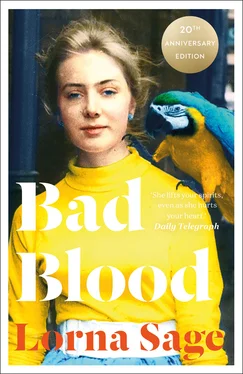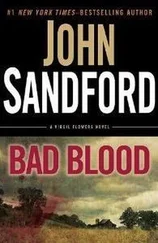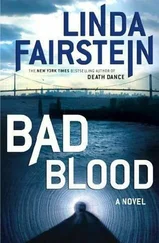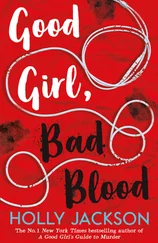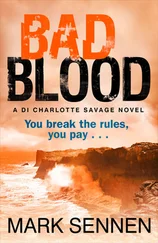The vicar, depending on whose side you are on, is either a faithless, cheating wastrel or a Romantic melancholic. He reminds me of Patrick Brontë, the half-mad father of the Brontë sisters who let off steam by sawing the legs off chairs, shredding his daughters’ dresses and firing loaded guns from the kitchen door. Lorna describes the vicar’s ‘defiant’ and ‘outrageous’ glamour as shamanistic, vampiric, Byronic; his past followed him, she says, ‘like a long, glamorous, sinister shadow’ and this same shadow hangs over these pages because the Vicar of St Chad’s is the spirit of Bad Blood . At the book’s centre are the diaries he kept in 1933 and 1934, in which he records his indiscretions and reveals, as Lorna wonderfully puts it, his ‘distinguishing trait’ to be ‘pride in his own awfulness’. He wrote a diary, she concludes, because he saw himself as a writer, but also to redeem his life from ‘the squalor of insignificance’. The squalor of insignificance : the phrase is painfully good, but then every line of Bad Blood is quotable. Lorna’s grandparents, for example, buried in same plot, are ‘rotting together for eternity, one flesh at last after a lifetime’s mutual loathing.’ The best term to describe Sage’s tone in these passages might be horrid laughter.
The Vicar was not, of course, a glamorous figure to anyone other than his granddaughter. A lonely and bitter man exiled in an illiterate parish, it is striking that it is his story and not her grandmother’s that moved her because, in her life as an academic, Lorna reclaimed the stories of women and not men, writing seminal studies of Angela Carter and Doris Lessing, and editing the vast Cambridge Guide to Women’s Writing in English.
When her grandfather dies in 1952, the genre of Bad Blood shifts from the gothic to what Lorna calls ‘socialist realism’. The family move from the spell-binding squalor of the vicarage to the wipeable surfaces of a 1950s council house, Lorna’s father returns to civilian life and a baby brother is born. There is also a subtle shift of class, one of several that Lorna will experience as she is propelled forwards. The newly formed nuclear unit is organised around a profoundly domestic mother who lacks, to a spectacular degree, any domestic skills and whose dominating feature is her fear of food. Could Valma have been anorexic? Sage doesn’t say, but the question hangs in the air: she had a horror of swallowing and so picked all day, occasionally bingeing on onions.
Socialist realism is replaced, in the book’s final section, by a parody of romance when the family move upwards again, this time to a large house with a gravel drive bought with the proceeds of Hilda’s blackmail campaign. The author’s sense of her life as a narrative is now so strongly ingrained that when her schoolteacher gives her some hairgrips for her unruly locks, Lorna concedes that ‘I was letting my hair down too early in the plot’. The plot twist, when it comes, is as much as surprise to her as it is to us.
There are several more borders to cross before the story draws to its close with Lorna entering adulthood against the grain. In the age of the Beatles and the Chatterley Trial she reads English at Durham University, a place whose buildings, ‘angular, hard-edged, ill-lit and draughty’, remind her of the vicarage. Here she meets the brilliant Nicholas Brooke (author of Horrid Laughter in Jacobean Tragedy ) who will go on to become her colleague at the University of East Anglia. With his ‘theatricality’, ‘bitterness’, ‘cradled cigarette’ and ‘flapping black gown’, Professor Brooke is the image of Lorna’s first mentor, the man whose skirts she would hang onto as they flapped in the wind on the churchyard path. Still moving forward, she is now ‘part of the shape of things to come.’
PART ONE
I The Old Devil and His Wife
Grandfather’s skirts would flap in the wind along the churchyard path and I would hang on. He often found things to do in the vestry, excuses for getting out of the vicarage (kicking the swollen door, cursing) and so long as he took me he couldn’t get up to much. I was a sort of hobble; he was my minder and I was his. He’d have liked to get further away, but petrol was rationed. The church was at least safe. My grandmother never went near it – except feet first in her coffin, but that was years later, when she was buried in the same grave with him. Rotting together for eternity, one flesh at the last after a lifetime’s mutual loathing. In life, though, she never invaded his patch; once inside the churchyard gate he was on his own ground, in his element. He was good at funerals, being gaunt and lined, marked with mortality. He had a scar down his hollow cheek too, which Grandma had done with the carving knife one of the many times when he came home pissed and incapable.
That, though, was when they were still ‘speaking’, before my time. Now they mostly monologued and swore at each other’s backs, and he (and I) would slam out of the house and go off between the graves, past the yew tree with a hollow where the cat had her litters and the various vaults that were supposed to account for the smell in the vicarage cellars in wet weather. On our right was the church; off to our left the graves stretched away, bisected by a grander gravel path leading down from the church porch to a bit of green with a war memorial, then – across the road – the mere. The church was popular for weddings because of this impressive approach, but he wasn’t at all keen on the marriage ceremony, naturally enough. Burials he relished, perhaps because he saw himself as buried alive.
One day we stopped to watch the gravedigger, who unearthed a skull – it was an old churchyard, on its second or third time around – and grandfather dusted off the soil and declaimed: ‘Alas poor Yorick, I knew him well …’ I thought he was making it up as he went along. When I grew up a bit and saw Hamlet and found him out, I wondered what had been going through his mind. I suppose the scene struck him as an image of his condition – exiled to a remote, illiterate rural parish, his talents wasted and so on. On the other hand his position afforded him a lot of opportunities for indulging secret, bitter jokes, hamming up the act and cherishing his ironies, so in a way he was enjoying himself. Back then, I thought that was what a vicar was, simply: someone bony and eloquent and smelly (tobacco, candle grease, sour claret), who talked into space. His disappointments were just part of the act for me, along with his dog-collar and cassock. I was like a baby goose imprinted by the first mother-figure it sees – he was my black marker.
It was certainly easy to spot him at a distance too. But this was a village where it seemed everybody was their vocation. They didn’t just ‘know their place’, it was as though the place occupied them, so that they all knew what they were going to be from the beginning. People’s names conspired to colour in this picture. The gravedigger was actually called Mr Downward. The blacksmith who lived by the mere was called Bywater. Even more decisively, the family who owned the village were called Hanmer, and so was the village. The Hanmers had come over with the Conqueror, got as far as the Welsh border and stayed ever since in this little rounded isthmus of North Wales sticking out into England, the detached portion of Flintshire (Flintshire Maelor) as it was called then, surrounded by Shropshire, Cheshire and – on the Welsh side – Denbighshire. There was no town in the Maelor district, only villages and hamlets; Flintshire proper was some way off; and (then) industrial, which made it in practice a world away from these pastoral parishes, which had become resigned to being handed a Labour MP at every election. People in Hanmer well understood, in almost a prideful way, that we weren’t part of all that. The kind of choice represented by voting didn’t figure large on the local map and you only really counted places you could get to on foot or by bike.
Читать дальше
